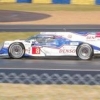Equalized cars and competitive cars are separate issues. If you want overtaking, then the way to achieve that is to provide a racing environment that gives a benefit to cars that overtake. This is in fact what a Renault member of the Overtaking Working Group said.
If one looks at current F1, the most important element of racing happens on Saturday: qualifying. Qualifying has resulted in cars that are not designed to overtake. They are designed to be fast, without any aero interference impeding them. There are rules even intended to ensure a car does get a free lap in clear air during qualifying: cars are not allowed to go slowly or block in qualifying. A couple of years ago, Alonso got a penalty, for staying 150 metres in front of a Ferrari, the Stewards found Alonso was interfering with the car behind him's grip due to aero wake, despite there being an average gap of 150 metres between the two cars. Alonso got penalized. So the cars have ended up being designed to work at their maximum in clean air in qualifying trim (which also is a race trim) and the rules support this situation.
The OWG did however say, that they did not want the cars to easily overtake. In other words, they did not want the car behind to have an advantage. They wanted to lower the two second differential between a car behind being able to overtake. They did that IMO.
However they did get one thing wrong, which was not expected. For this season, the cars have more mechanical grip, for the following reasons:
- Greater contact patch of the same tyres but with the grooves removed;
- Less aero downforce;
- Higher and narrow rear wing mean't to lower aero wake damaging trailing cars downforce;
- Adjustable front wing at the front was mean't to allow greater front grip when close behind; and
- Also KERS 6 seconds of extra power (mean't to be doubled in power for 2010)
All these things have worked (perhaps the DDD has added some non planned for aero turbulence and added greater overall aero downforce/grip as well).
Overall, a significant change in the overall mechancal grip compared to aero derived grip has happened with F1 cars.
One might ask, surely more mechanical grip would encourage more overtaking? This was the clear goal of the OWG. But in fact, what has happened is that if one tries to overtake, you can wreck your tyres. And because the cars are more reliant on mechanical grip than in recent year, the tyre condition has become more important than ever before. And if your tyres go off, then you get much slower than in previous seasons. Most F1 fans would recall this year Seb Vettel coming in after just 8 laps when his tyres went off.
So what has happened, is that typically a car will sit behind, about one and half seconds behind allows a car to keep its tyres in good conditon. Any closer, and the tyres start to slip a bit and get worn. So you sit behind, save fuel, and wait. When the car in front pits, then one's tyres are still in good condition, and then you can go for it, greatly increase your speed, and gain places due to having kept your tyres in good condition.
Obviously if overtaking is wanted, the rules concerning qualifying need to be changed. Give the designers a benefit to overtaking, and they will then design cars that overtake. Right now the rules do not provide a benefit in designing a better overtaking car. A lottery for the grid positions would do that though. Instead of qualifying, there could be two races too. With the second race on Sunday, and with the grid being chosen due to having a reverse grid. And give the trophy to the best overall results of the two races. If there's a draw, the trophy goes to who did best on the Sunday (the points would be the same though).
These things have nothing to do with team budgets.
Edited by Melbourne Park, 09 August 2009 - 22:50.



























